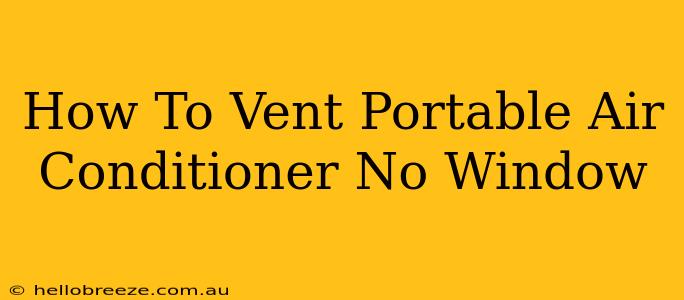Summer heat got you sweating? A portable air conditioner can be a lifesaver, but venting it without a window can seem tricky. This comprehensive guide provides several effective methods to successfully vent your portable AC and keep your space cool and comfortable.
Understanding Portable AC Ventilation
Portable air conditioners work by drawing in warm air, cooling it, and then expelling the hot air outside. This exhaust air needs to be vented effectively to prevent the unit from overheating and to maximize cooling efficiency. Without proper ventilation, your unit will struggle to cool, and may even malfunction.
Why Window Venting Isn't Always Possible
Many people assume that window venting is the only option. However, situations like apartment living, renting restrictions, or a lack of suitable windows can make window venting impossible. Fear not! There are alternative solutions.
Creative Venting Solutions for Portable Air Conditioners
Let's explore some effective ways to vent your portable AC without relying on a window:
1. Utilizing a Window Kit with an Extension Hose
While you might not have a suitable window, you can potentially use a window kit with a longer extension hose to reach a more accessible ventilation point. This might be a slightly less aesthetically pleasing solution, but it's still feasible and effective in many situations. Consider the following:
- Assess your surroundings: Identify a location where you can safely and effectively exhaust the hot air—this could be a nearby door, a gap in a wall, or even a slightly open window in another room.
- Measure the distance: Accurately measure the distance between your portable AC and the chosen exhaust point.
- Purchase the appropriate extension hose: Ensure you buy a hose that is long enough and compatible with your unit’s exhaust port.
Important Note: Always securely fasten the extension hose to both the air conditioner and the chosen exhaust point. Loose connections can reduce cooling efficiency and lead to problems.
2. Vent Through a Wall (with Caution)
Vent a portable air conditioner through an existing wall opening? This is the most effective method, but also one that requires some care and DIY skill.
- Professional Installation is Recommended: Unless you are experienced with home renovations, consult a professional. Incorrect installation can lead to problems with your air conditioner or even structural damage to your home.
- Drill a Hole (with Expert Guidance): A professional can carefully drill a hole in an exterior wall to accommodate the exhaust hose. Ensure the hole is sealed properly and weatherproofed to prevent drafts and leaks.
3. The DIY Flexible Ducting Method
This is a more improvisational approach, best suited for temporary situations:
- Gather Materials: You'll need a length of flexible ductwork (available at most home improvement stores), duct tape, and potentially some sealant to secure the connections.
- Create an Exhaust Path: Carefully guide the flexible duct from your air conditioner’s exhaust to a safe external location. Ensure that the duct is securely fastened and free from kinks or obstructions.
Caution: This method might be less efficient than the others.
4. Using a Doorway for Ventilation
If there's a secure and safe way to vent the air conditioner through a doorway, this method might be a viable option, especially in a pinch. This will likely involve:
- Creating a Seal: Use towels or other materials to create a seal around the hose to prevent air leakage.
- Careful Placement: Position the hose to minimize any disruption or inconvenience.
This is less ideal due to a risk of air leaking back into your space.
Choosing the Right Method for You
The best venting method depends on your specific circumstances, the type of building you're in, and your DIY skills. Always prioritize safety and efficiency when selecting a method for venting your portable air conditioner. If you're uncertain about any aspect of this process, contact a qualified HVAC professional. They can advise on the most appropriate and safe method for your situation.

